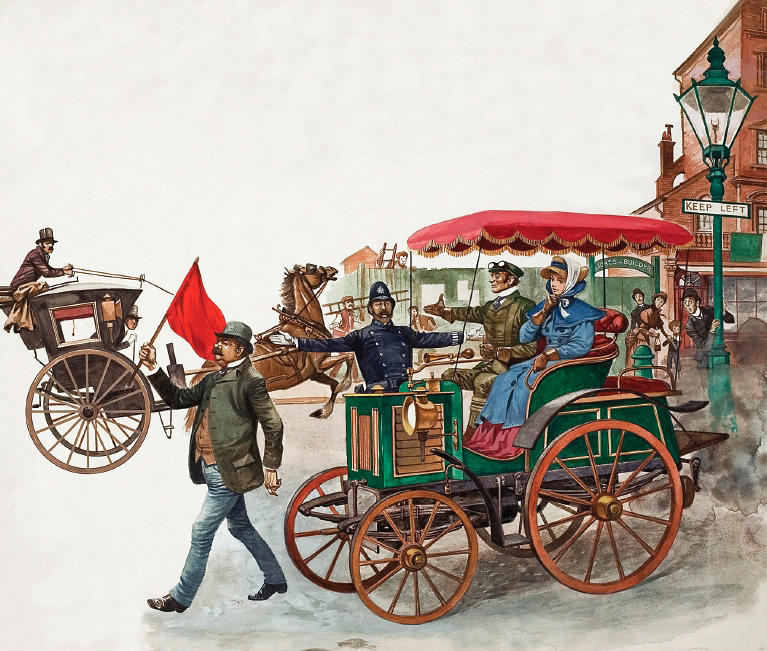
The Locomotive Acts of 1861, 1865 and 1878 set the United Kingdom’s earliest speed limits for road-going vehicles; powered passenger vehicles were at the time known as light locomotives, as they were invariably powered by steam.[a]Gottlieb Daimler’s first patents for an internal combustion engine suitable for use in a motor vehicle date from 1884, but it was not until 1889 that his engines began to be produced in any great quantity.[1] Early steam-powered vehicles met with some opposition in Great Britain, as they were seen as a potential threat to the powerfully entrenched coaching industry.[2] But the era of horse-drawn road transport had reached its zenith by 1838, after which the rapid development of railways led to its demise.[3]
The Locomotive Act 1861 was the first to set speed limits for road-going vehicles in the UK; speeds in rural areas were limited to 10 mph (16 km/h) and in urban areas to 5 mph (8 km/h).[b]Walter ArnoldFirst person in the UK to be fined for speeding. was the first driver ever to be fined for speeding, through the village of Paddock Wood in Kent at 8 mph (13 km/h), on 28 January 1896. The Act also imposed the “impossible” restriction that the vehicles were to consume their own smoke. The “notorious” Locomotive Act of 1865, commonly known as the Red Flag Act, reduced the speed limits to 4 mph (6 km/h) in the country and 2 mph (3 km/h) in the city. It further mandated that each road-going locomotive was to be manned by a crew of three, one of whom was obliged to walk in front of the vehicle carrying a red flag during the hours of daylight, or a lantern at night;[c]There was no similar requirement for railway locomotives.[4] it did however loosen the onerous restriction for vehicles to consume their own smoke to “so far as practicable”.[5] No other European country introduced similar legislation, which imposed a significant restraint on the early development of the motor car in Britain.[4]
The Highways and Locomotives (Amendment) Act 1878 reduced the minimum distance by which an accompanying pedestrian should precede the vehicle to 20 yards (18 m), and that requirement remained in place until the passage of the Light Locomotives on Highways Act 1896, which increased the speed limit to 14 mph (23 km/h) for mechanically propelled vehicles on open roads, a speed somewhat in excess of that which a pedestrian could reasonably be expected to sustain.[4]
Notes
| a | Gottlieb Daimler’s first patents for an internal combustion engine suitable for use in a motor vehicle date from 1884, but it was not until 1889 that his engines began to be produced in any great quantity.[1] |
|---|---|
| b | Walter ArnoldFirst person in the UK to be fined for speeding. was the first driver ever to be fined for speeding, through the village of Paddock Wood in Kent at 8 mph (13 km/h), on 28 January 1896. |
| c | There was no similar requirement for railway locomotives.[4] |
